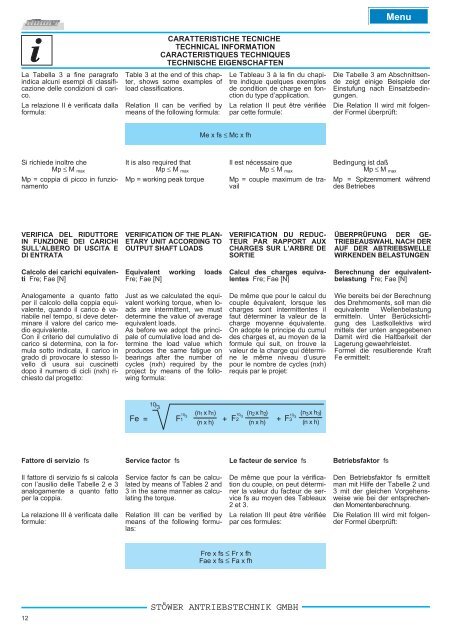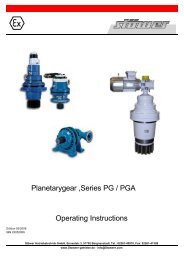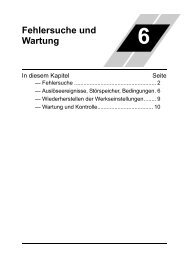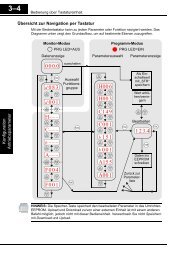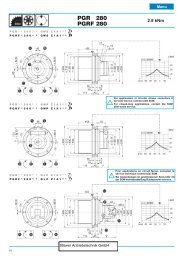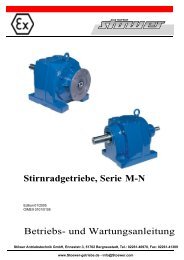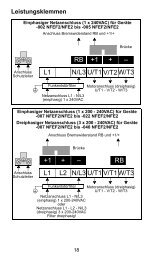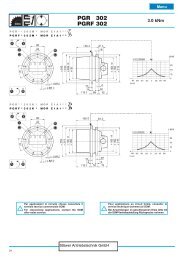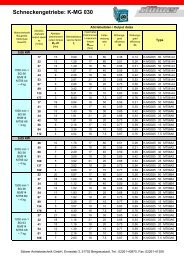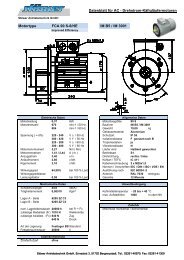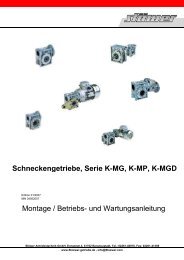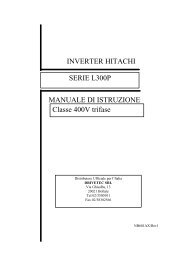pg _ pga series - Stoewer-Getriebe.de
pg _ pga series - Stoewer-Getriebe.de
pg _ pga series - Stoewer-Getriebe.de
You also want an ePaper? Increase the reach of your titles
YUMPU automatically turns print PDFs into web optimized ePapers that Google loves.
La Tabella 3 a fine paragrafo<br />
indica alcuni esempi di classificazione<br />
<strong>de</strong>lle condizioni di carico.<br />
La relazione II è verificata dalla<br />
formula:<br />
Si richie<strong>de</strong> inoltre che<br />
Mp ≤ M max<br />
Mp = coppia di picco in funzionamento<br />
VERIFICA DEL RIDUTTORE<br />
IN FUNZIONE DEI CARICHI<br />
SULL’ALBERO DI USCITA E<br />
DI ENTRATA<br />
Calcolo <strong>de</strong>i carichi equivalenti<br />
Fre; Fae [N]<br />
Analogamente a quanto fatto<br />
per il calcolo <strong>de</strong>lla coppia equivalente,<br />
quando il carico è variabile<br />
nel tempo, si <strong>de</strong>ve <strong>de</strong>terminare<br />
il valore <strong>de</strong>l carico medio<br />
equivalente.<br />
Con il criterio <strong>de</strong>l cumulativo di<br />
carico si <strong>de</strong>termina, con la formula<br />
sotto indicata, il carico in<br />
grado di provocare lo stesso livello<br />
di usura sui cuscinetti<br />
dopo il numero di cicli (nxh) richiesto<br />
dal progetto:<br />
Fattore di servizio fs<br />
Il fattore di servizio fs si calcola<br />
con l’ausilio <strong>de</strong>lle Tabelle 2e3<br />
analogamente a quanto fatto<br />
per la coppia.<br />
La relazione III è verificata dalle<br />
formule:<br />
12<br />
CARATTERISTICHE TECNICHE<br />
TECHNICAL INFORMATION<br />
CARACTERISTIQUES TECHNIQUES<br />
TECHNISCHE EIGENSCHAFTEN<br />
Table 3 at the end of this chapter,<br />
shows some examples of<br />
load classifications.<br />
Relation II can be verified by<br />
means of the following formula:<br />
It is also required that<br />
Mp ≤ M max<br />
Mp = working peak torque<br />
VERIFICATION OF THE PLAN-<br />
ETARY UNIT ACCORDING TO<br />
OUTPUT SHAFT LOADS<br />
Equivalent working loads<br />
Fre; Fae [N]<br />
Just as we calculated the equivalent<br />
working torque, when loads<br />
are intermittent, we must<br />
<strong>de</strong>termine the value of average<br />
equivalent loads.<br />
As before we adopt the principale<br />
of cumulative load and <strong>de</strong>termine<br />
the load value which<br />
produces the same fatigue on<br />
bearings after the number of<br />
cycles (nxh) required by the<br />
project by means of the following<br />
formula:<br />
10 /3<br />
Service factor fs<br />
Service factor fs can be calculated<br />
by means of Tables 2 and<br />
3 in the same manner as calculating<br />
the torque.<br />
Relation III can be verified by<br />
means of the following formulas:<br />
Mexfs≤ Mcxfh<br />
Frexfs≤ Frxfh<br />
Faexfs≤ Faxfh<br />
Le Tableau 3 à la fin du chapitre<br />
indique quelques exemples<br />
<strong>de</strong> condition <strong>de</strong> charge en fonction<br />
du type d’application.<br />
La relation II peut être vérifiée<br />
par cette formule:<br />
Il est nécessaire que<br />
Mp ≤ M max<br />
Mp = couple maximum <strong>de</strong> travail<br />
VERIFICATION DU REDUC-<br />
TEUR PAR RAPPORT AUX<br />
CHARGES SUR L’ARBRE DE<br />
SORTIE<br />
Calcul <strong>de</strong>s charges equivalentes<br />
Fre; Fae [N]<br />
De même que pour le calcul du<br />
couple équivalent, lorsque les<br />
charges sont intermittentes il<br />
faut déterminer la valeur <strong>de</strong> la<br />
charge moyenne équivalente.<br />
On adopte le principe du cumul<br />
<strong>de</strong>s charges et, au moyen <strong>de</strong> la<br />
formule qui suit, on trouve la<br />
valeur <strong>de</strong> la charge qui détermine<br />
le même niveau d’usure<br />
pour le nombre <strong>de</strong> cycles (nxh)<br />
requis par le projet:<br />
( n1 x h1) ( n2x h2) 10 ( n3x<br />
h3)<br />
/3<br />
3<br />
( n x h) ( n x h) ( n x h)<br />
10 /3<br />
10 /3<br />
Fe = F1 + F2 + F<br />
Le facteur <strong>de</strong> service fs<br />
De même que pour la vérification<br />
du couple, on peut déterminer<br />
la valeur du facteur <strong>de</strong> service<br />
fs au moyen <strong>de</strong>s Tableaux<br />
2et3.<br />
La relation III peut être vérifiée<br />
par ces formules:<br />
STÖWER ANTRIEBSTECHNIK GMBH<br />
Die Tabelle 3 am Abschnittsen<strong>de</strong><br />
zeigt einige Beispiele <strong>de</strong>r<br />
Einstufung nach Einsatzbedingungen.<br />
Die Relation II wird mit folgen<strong>de</strong>r<br />
Formel überprüft:<br />
Bedingung ist daß<br />
Mp ≤ M max<br />
Mp = Spitzenmoment während<br />
<strong>de</strong>s Betriebes<br />
ÜBERPRÜFUNG DER GE-<br />
TRIEBEAUSWAHL NACH DER<br />
AUF DER ABTRIEBSWELLE<br />
WIRKENDEN BELASTUNGEN<br />
Berechnung <strong>de</strong>r equivalentbelastung<br />
Fre; Fae [N]<br />
Wie bereits bei <strong>de</strong>r Berechnung<br />
<strong>de</strong>s Drehmoments, soll man die<br />
equivalente Wellenbelastung<br />
ermitteln. Unter Berücksichtigung<br />
<strong>de</strong>s Lastkollektivs wird<br />
mittels <strong>de</strong>r unten angegebenen<br />
Damit wird die Haltbarkeit <strong>de</strong>r<br />
Lagerung gewaehrleistet.<br />
Formel die resultieren<strong>de</strong> Kraft<br />
Fe ermittelt:<br />
Betriebsfaktor fs<br />
Menu<br />
Den Betriebsfaktor fs ermittelt<br />
man mit Hilfe <strong>de</strong>r Tabelle 2 und<br />
3 mit <strong>de</strong>r gleichen Vorgehensweise<br />
wie bei <strong>de</strong>r entsprechen<strong>de</strong>n<br />
Momentenberechnung.<br />
Die Relation III wird mit folgen<strong>de</strong>r<br />
Formel überprüft:


